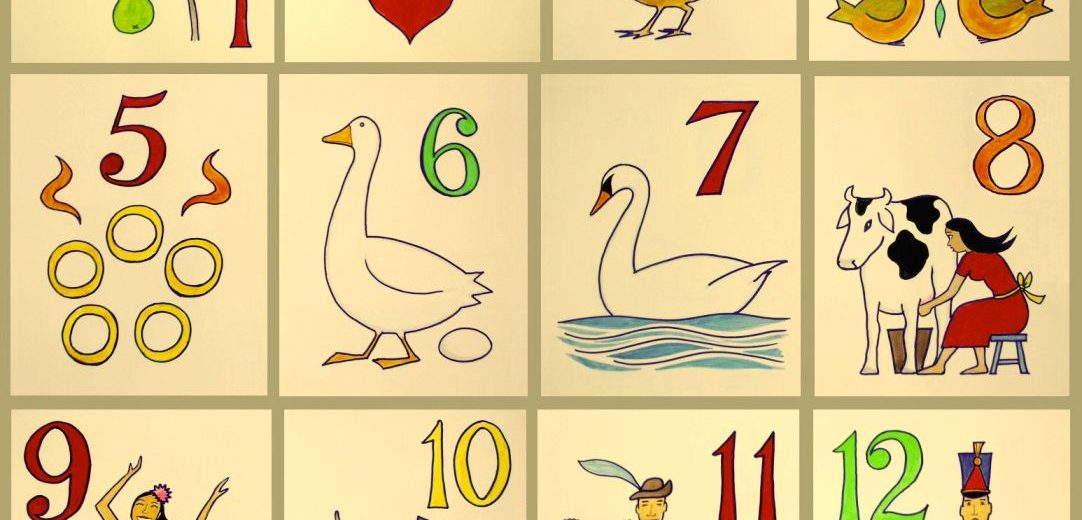
12 Ways to teach The 12 Days of Christmas
 I have always loved teaching the 12 Days of Christmas! There are so many fun and funny ways to make this song relevant to your kiddos and lots of great activities to go along with it. I’ve taught the 12 Days in a lot of different ways and thought I would share some ideas with you here.
I have always loved teaching the 12 Days of Christmas! There are so many fun and funny ways to make this song relevant to your kiddos and lots of great activities to go along with it. I’ve taught the 12 Days in a lot of different ways and thought I would share some ideas with you here.
Some of these could be fleshed out to full lessons and some of them are just accompanying activities… but all of them could be a ton of fun! Maybe you teach one of these at one grade level and use another more advanced activity with an older grade. Feel free to add a comment at the end of the blog post about how YOU use this song in your classroom!
#1 – Sing the Song… and that’s it
#2 – Sing with visual supports
 This is my preference. I don’t usually hand out paper copies and sing songs written down on a song sheet. For one, I know that I have struggling readers in my building who might see a song sheet and “check out” of the activity because they just can’t read it well (and there are some weird words in this song that would make reading hard for struggling readers). I’ve spent some time in the last few years working with our reading intervention teacher and monitoring kids’ reading. I’ve found that it is very difficult for struggling readers read “fluently” the first time. They often stumble over words and have to go back and try things again and it makes their reading feel broken/bumpy and not smooth and steady. To be able to read quickly and “in time” with a song while also singing and listening to the group is nearly impossible for even the best readers in an elementary school. For that reason, handing out a paper copy and asking them to sight read/sing it is probably not a great idea.
This is my preference. I don’t usually hand out paper copies and sing songs written down on a song sheet. For one, I know that I have struggling readers in my building who might see a song sheet and “check out” of the activity because they just can’t read it well (and there are some weird words in this song that would make reading hard for struggling readers). I’ve spent some time in the last few years working with our reading intervention teacher and monitoring kids’ reading. I’ve found that it is very difficult for struggling readers read “fluently” the first time. They often stumble over words and have to go back and try things again and it makes their reading feel broken/bumpy and not smooth and steady. To be able to read quickly and “in time” with a song while also singing and listening to the group is nearly impossible for even the best readers in an elementary school. For that reason, handing out a paper copy and asking them to sight read/sing it is probably not a great idea.
So instead I would show them a powerpoint with some visual aids and a few little tricks to help them. Here’s an example of a powerpoint that I made to help my students feel more successful with the song. This powerpoint presentation has clip art images of the various presents/animals/items in the song. Using these clip art pictures as icons, the kids remember the words a lot faster and don’t get stuck in the process of reading all the words. Also, they have a ton of fun looking at the different kinds of animals and putting a word to an image. Struggling readers (especially English Language Learners) can really benefit from a presentation like this!
#3 – Divide and Conquer
One fun thing to do with kids is separate the class into 12 groups and then print off the different slides of the song and hand out one gift to each group. When you sing the whole song, each mini-group could sing the words that go along with their gift. This allows kids to feel ownership of one part of the song and encourages solos and small-group singing. It also means that students aren’t responsible for singing every word (and for some kids it’s really hard to remember all the different parts!).The Muppets did a really wonderful version of this song with John Denver where each muppet gets a little part of the song. Check out this video to see how they sing the song and you’ll understand the strategy that I’m talking about when I say, “Divide and Conquer.“
One really hilarious extension to this idea is to encourage each mini-group to come up with a creative movement or action to go along with their word. I tried this once with my class and I almost couldn’t sing or play the piano because I was laughing so hard. A group of three boys got the milking maids and one acted like the cow while the other milked him and the third was the milking stool that the maid sat on. This wasn’t as bad as the “leaping lords,” where two kiddos in the group kneeled down and the third leapt over them whenever we got to their part.
#4 – Bunches of Birds – Giving Context
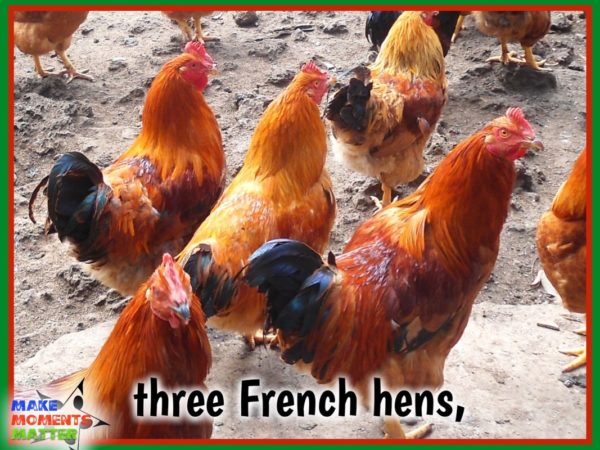 I love spending time with kids talking about the different gifts that the true love gives out. There are a lot of birds initially, which starts some pretty interesting conversations. Why was he giving out birds? We talk about the kind of birds and why someone might give birds as a gift at all. A short discussion helps kids understand that this is a song and story from a long time ago where birds were a great gift for a variety of reasons: songbirds for sound and companionship, birds for eggs, birds for foods, etc. It helps to bring context to the song and makes it more real.I also love giving kids more information about each of the gifts. They might be able to tell you the different between a goose and a swan, but I bet they couldn’t pick a partridge out of a lineup. That’s when I pull out this version of the song with real images of the birds (and all the other gifts). We compare the clip art versions to the real birds and in this PowerPoint I also have a slide with embedded sounds so that kiddos can hear the birdsong of the partridge and hear what the turtledoves sound like. It’s amazing when their faces light up as they say, “I HAVE heard those before! I didn’t know that’s what those birds sounded like!”
I love spending time with kids talking about the different gifts that the true love gives out. There are a lot of birds initially, which starts some pretty interesting conversations. Why was he giving out birds? We talk about the kind of birds and why someone might give birds as a gift at all. A short discussion helps kids understand that this is a song and story from a long time ago where birds were a great gift for a variety of reasons: songbirds for sound and companionship, birds for eggs, birds for foods, etc. It helps to bring context to the song and makes it more real.I also love giving kids more information about each of the gifts. They might be able to tell you the different between a goose and a swan, but I bet they couldn’t pick a partridge out of a lineup. That’s when I pull out this version of the song with real images of the birds (and all the other gifts). We compare the clip art versions to the real birds and in this PowerPoint I also have a slide with embedded sounds so that kiddos can hear the birdsong of the partridge and hear what the turtledoves sound like. It’s amazing when their faces light up as they say, “I HAVE heard those before! I didn’t know that’s what those birds sounded like!”
#5 – Act Out the Story
#6 – Change the Context – Modernize
#7 – New Gifts — New Story
#8 -Discuss Cumulative Form – With the Muppets!
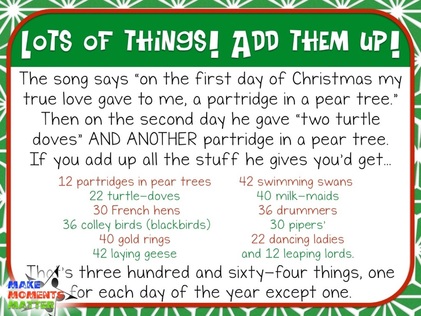 I love talking about song form with kiddos. When you start to discuss a song’s form it makes it easier for kids to learn and sing. Kids are taught to look for patterns and so pointing out the form of a song makes it feel like pattern recognition. Kids can see the pattern and then when they get to a “repeated” part they can sing it more easily because they already know the music. A great example of this is “O Tannenbaum” because it’s an AABA form. Once kids get that form into their head then they realize they only have to really learn two sections of music, A and B, and just repeat A a few times.
I love talking about song form with kiddos. When you start to discuss a song’s form it makes it easier for kids to learn and sing. Kids are taught to look for patterns and so pointing out the form of a song makes it feel like pattern recognition. Kids can see the pattern and then when they get to a “repeated” part they can sing it more easily because they already know the music. A great example of this is “O Tannenbaum” because it’s an AABA form. Once kids get that form into their head then they realize they only have to really learn two sections of music, A and B, and just repeat A a few times.
With this song I make sure to point out the cumulative form. We keep adding and adding and filling in new words. Another great example of cumulative form is “I Had a Rooster” where you keep adding new animals that the farmer owned and fed. Kids love cumulative songs as they feel almost like a challenge to them. I love to throw in this slide that talks about how the “true love” is giving away a lot of different animals if they really are accumulating all those things!
And here’s where the Muppets come in! I love showing the original video with John Denver where each Muppet gets a differnet part of the song (I included the link up above on #3). In fact, I show that video before I show this new video below. Again, this is to give them a baseline understanding of the song. That way kids know the premise of each Muppet singing their own thing. After I’ve shown them the first videos, I show them this movie of a house that lights up to the Muppet’s song. It’s a GREAT example of cumulative form because a new light or set of lights is added with each new verse. Kids LOVE to watch this!
#9 – Sing and Learn the Alternate Melody
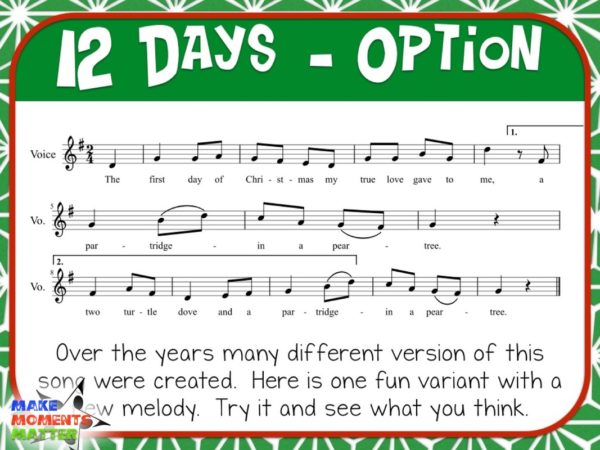 Did you know that there is an ALTERNATE melody to this song? I sure didn’t know about any other version of this song before I did some digging for a “Favorite Carol” set I did a few years ago. The traditional version of the song that we know is a lot more popular nowadays but this alternate version feels a lot more lyrical to me. The lyrical version comes from a long way back into the history of the song and for some reason just wasn’t as popular and got lost along the way.
Did you know that there is an ALTERNATE melody to this song? I sure didn’t know about any other version of this song before I did some digging for a “Favorite Carol” set I did a few years ago. The traditional version of the song that we know is a lot more popular nowadays but this alternate version feels a lot more lyrical to me. The lyrical version comes from a long way back into the history of the song and for some reason just wasn’t as popular and got lost along the way.
One thing that I like specifically about this version is that the music doesn’t change after the 5th verse. In the “traditional” 12 days song, the melody is different and repetative for verses 6 through 12 but after the 5 golden rings gifts 4 through 1 have a different melody. With the alternate version I mention here, all the gifts have the same melody througout the entirity of the song (which might make the 12 Days a little easier to sing in some situations).
Why sing a different melody? Well, it’s fun to show how variation works and how even a familiar song can be done in a different way. It would be super cool to sing this version of the song alongside the traditional version for a concert or if you go caroling through the neighborhood. It would probably be totally new and novel for an audience to hear.
#10 – Sing and Play – Memory Game
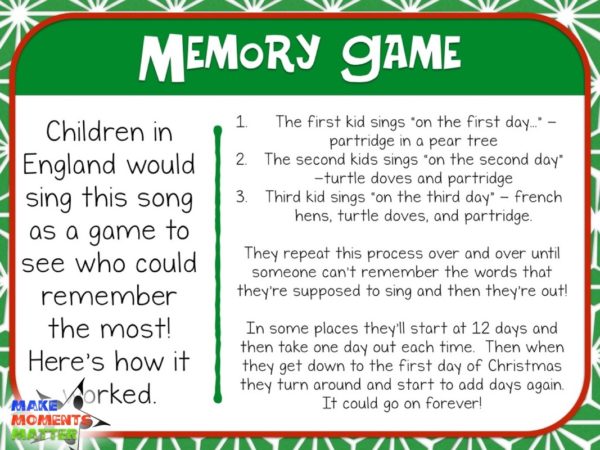 This is another relic from the long history of this famous folk song. Years ago, children in England would sing this song as a game to see who could remember the most! Here’s how it worked: 1. The first kid sings “on the first day…” – partridge in a pear tree. 2. The second kids sings “on the second day” -turtle doves and partridge, 3. Third kid sings “on the third day” – french hens, turtle doves, and partridge. They repeat this process over and over until someone can’t remember the words that they’re supposed to sing and then they’re out! Click the image to enlarge and see more of the directions.
This is another relic from the long history of this famous folk song. Years ago, children in England would sing this song as a game to see who could remember the most! Here’s how it worked: 1. The first kid sings “on the first day…” – partridge in a pear tree. 2. The second kids sings “on the second day” -turtle doves and partridge, 3. Third kid sings “on the third day” – french hens, turtle doves, and partridge. They repeat this process over and over until someone can’t remember the words that they’re supposed to sing and then they’re out! Click the image to enlarge and see more of the directions.
#11 – Add in Instrument Exploration
#12 – Video Extensions
- This “Favorite Carol” kit is intended to help you teach the song and reinforce historical content and vocabulary at the same time. The set could be printed out and posted on a bulletin board or used as reference cards as you teach the lesson. I know there are some folks on carts or who primarily use digital projectors so I’ve included a PowerPoint format of the set as well.
- Many students don’t really know what a partridge, milking maid, turtle dove, or swan look or sound like! So, in this PowerPoint I included REAL pictures of the animals/characters that we sing about as well as REAL sounds that those animals/people make! I’ve also included a set of slides with clip art images in case you’d like to teach the song that way.

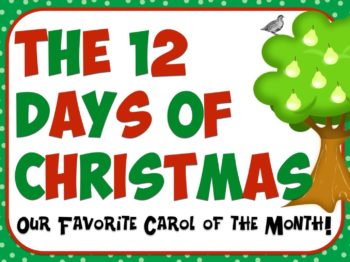
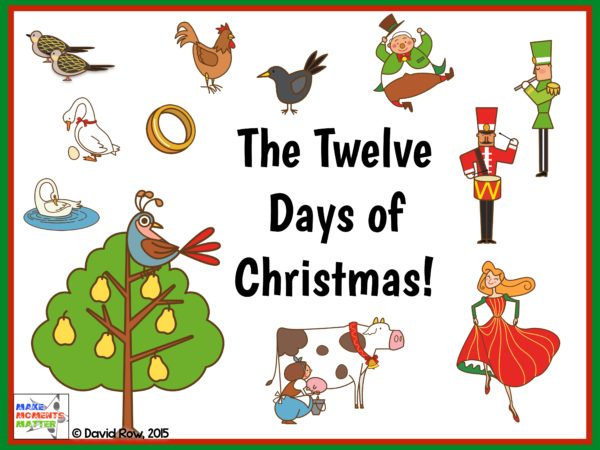

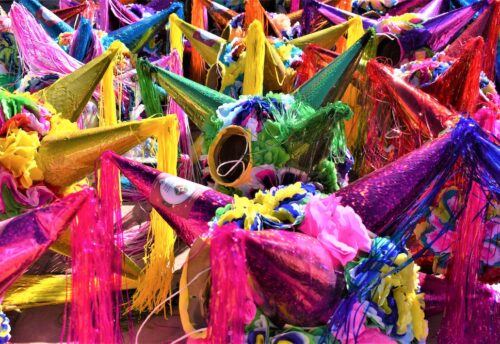
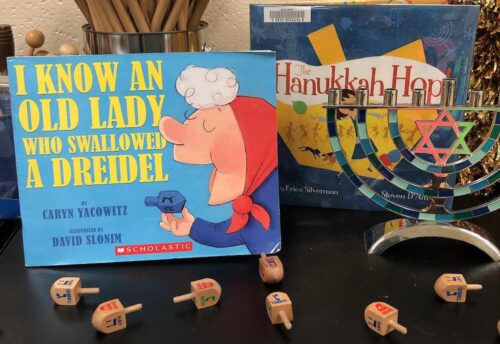
2 Comments